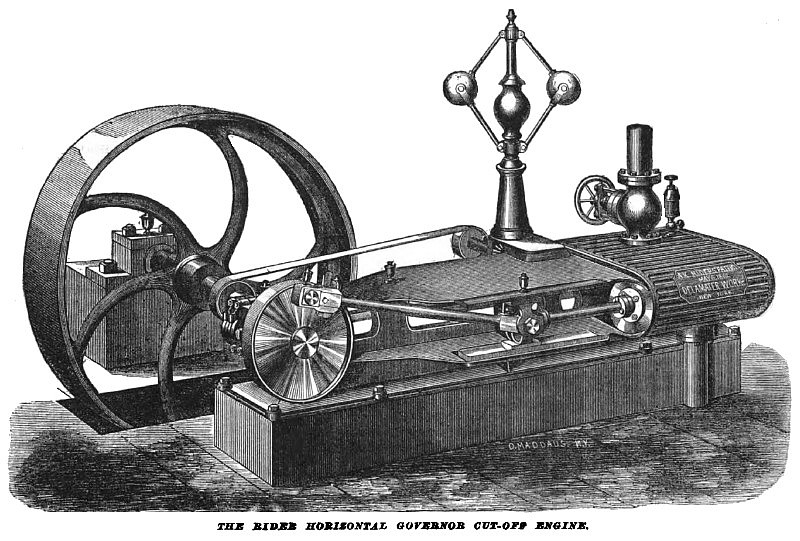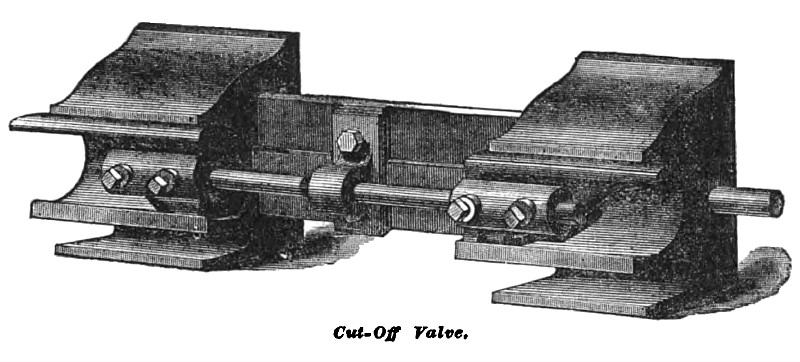|
Title: |
1871 Article-DeLamater Iron Works, Horizontal Governor Cut-Off Steam Engine |
|
Source: |
Manufacturer & Builder, V3, Oct 1871, pg. 234 |
|
Insert Date: |
2/25/2017 8:05:26 PM |
Expansion of Steam versus Condensation
It is well known that steam, when ejected under pressure from an opening, is transparent near the jet, and only at a distance becomes visible as a vapor; and besides, is much hotter at the point of exit than at a slight distance therefrom; so that at a certain point wo may even keep our hand in the jet, and in place of feeling heat even perceive a sensation of coolness. This is according to the laws of the relations of heat to expanding and contracting gases and vapors; a force producing condensation of a gas is transformed into heat, or heat is generated, and when this or any other gas or vapor is allowed to expand, the reverse takes place; heat is absorbed and disappears, which is equivalent to cooling. As now, in a non-condensing steam-engine, the waste steam is simply ejected, a great deal of heat is given off and lost in the air which, if it could be made to do duty in the engine and transformed into force, like the other portions of the heat from which the power of the engine is derived, would result in a saving of fuel. The oldest way of accomplishing this is by means of the condensation of the steam, a vacuum being produced on one side of the cylinder and some 12 to 14 pounds pressure saved; the greater portion of the heat otherwise wasted remaining in the engine.
The latter condition is so important that it is now being introduced as a comparative test of the value of different engines; that engine being the best in which the least heat is lost in the water of condensation or in the exhaust steam, which, for the purpose of testing, is blown into cold water and its heat thus measured.
The so-called cut-off arrangement accomplishes the same thing as the condensation by expansion of the steam when applied to the cylinder of an engine. It cuts the steam off when the piston has made only a part of the stroke, while during the rest, the piston is propelled by the expanding steam, which, by this very expansion, is so cooled as to leave the engine at a much lower temperature than it otherwise would be. It is clear that when cutting off at half-stroke, only half the amount of steam is consumed; but considerable more than half the amount of power is obtained. The only question now to be solved is how to regulate this cut-off arrangement so as to obtain the most economical results. In the Rider horizontal engine, represented in our figure, this regulating power is obtained from the governor. When the machine runs slowly and the balls fall, the cut-off arrangement does not work at all, and the steam is admitted full stroke; but as soon as the engine commences to run Bo rapidly as to lift the balls, it comes in operation, and is so arranged that, when the balls reach the highest possible position, the steam cuts off at the beginning of the stroke, and in like manner when they are half-way raised the steam is cut off at half-stroke, etc.
It is evident that an engine with such an arrangement must run very regularly under all circumstances; if, in case it should be suddenly relieved from a portion of its labor by the throwing off of a belt, the more rapid motion the engine would be apt to acquire would be suddenly checked by the rising of the governor-balls and their consequent action on the cut-off. This cut-off arrangement is represented in our second figure.
The cut-off valve is a section of a cylinder with its ends cut obliquely in opposite directions, so that the extremities or acting ends conform to the lines of a right and left hand screw of high pitch, corresponding to the obliquity or angle of the steam ports in the back of the main slide-valve. It is operated lengthwise by the eccentric, and a rotating, adjusting motion around its axis is imparted by the governor, to the action of which this arrangement makes it very sensitive.
An engine of the kind described is now in operation at the Fair of the American Institute.
US Patent: 35,176
http://datamp.org/patents/displayPatent.php?number=35176&typeCode=0 |
|
 1871 Article-DeLamater Iron Works, Horizontal Governor Cut-Off Steam Engine
1871 Article-DeLamater Iron Works, Horizontal Governor Cut-Off Steam Engine
 1871 Article-DeLamater Iron Works, Steam Engine Cut-Off Valve
1871 Article-DeLamater Iron Works, Steam Engine Cut-Off Valve
|
|